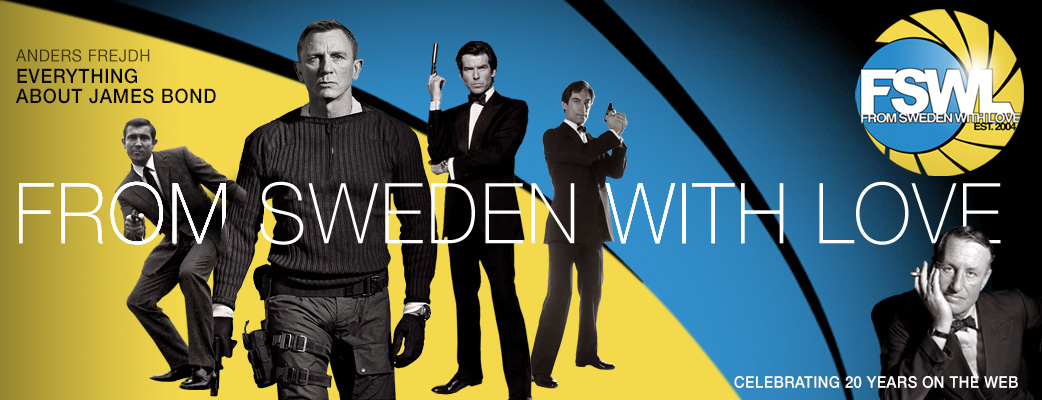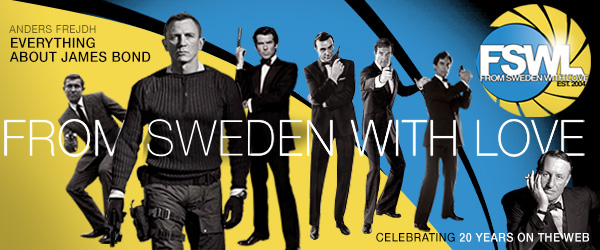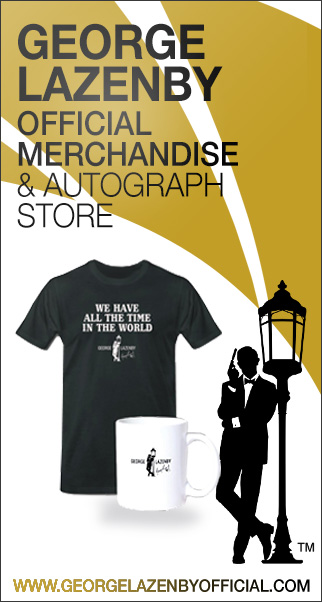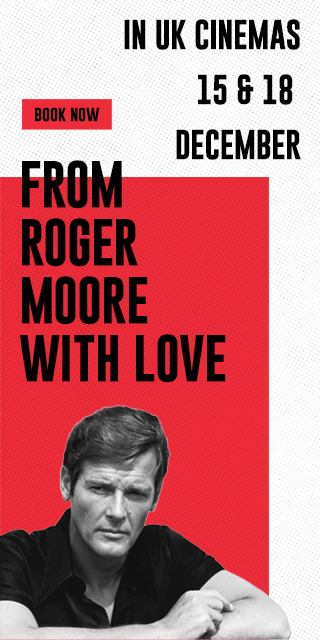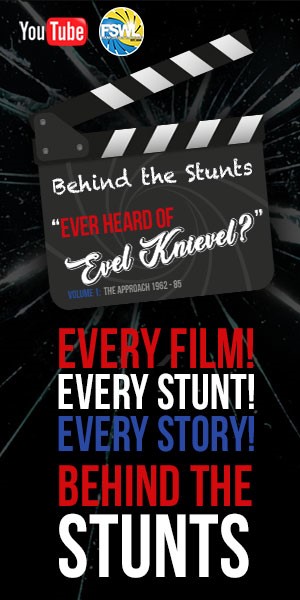Website last updated: 10-6-2025
Home
Book & Film reviews
Competitions
Event
FSWL Merchandise
Interviews
James Bond 007 articles
James Bond 007 collection
James Bond 007 films
James Bond 007 games
James Bond 007 literature
James Bond 007 news
James Bond 007 products
James Bond 007 shop
James Bond 007 stars
James Bond Fan Clubs
Swedes in the Bond films
In Memoriam of SFX Maestro John Stears (1934-1999)
By: Anders Frejdh
Published:
2004-09-06
2004-09-06

John Stears was one of the film industry's top men for special visual effects and many of his innovations are incorporated into the work of today's film-makers.
For the early James Bond films, he served as the real-life incarnation of the ingenious "Q", creating such gadgets and vehicles as the Aston Martin of Goldfinger which has been described as "the most famous car in the world". For Star Wars he worked with the production designer John Barry to conceive the unforgettable robots C3PO and R2-D2, and among his other memorable achievements were the flying car of Chitty Chitty Bang Bang, the model work for the British film about the Titanic, A Night to Remember, and the explosive demolition work in The Guns of Navarone.
Born in 1934, Stears studied at Harrow College of Art and Southall Technical School before working as a draughtsman with the Air Ministry. He served as a dispatch rider during his National Service, then joined a firm of architects where he was able to utilise his passion for model-making by constructing scale models of building projects for clients.
The firm also specialised in model aircraft, and when Rank's special effects expert Bill Warrington saw some of Stears's work he commissioned him to build model aircraft for Lewis Gilbert's screen version of the life of the pilot Douglas Bader, Reach for the Sky (1956).
Signed to a contract by the Rank Organisation, Stears worked with Warrington and Gilbert on three more true-life stories, creating model boats and planes for A Night to Remember (1958), in which Kenneth More, who had played Bader, was Second Officer Lightoller of the Titanic, Carve Her Name With Pride (1958), which starred Virginia McKenna as the British shop assistant Violette Szabo who became a resistance heroine, and Sink the Bismarck! (1960), with Kenneth More as an Admiralty captain intent on destroying Germany's prize battleship. Other Rank films included The One That Got Away (1957), Sea Fury (1958) and Gilbert's HMS Defiant (1962).
Having acquired a reputation impressive enough for him to freelance, Stears was hired to both build and destroy gun miniatures for J. Lee Thompson's exciting transcription of the Alistair MacLean adventure tale The Guns of Navarone (1961), then he created effects for two Disney films, In Search of the Castaways (1962) and the fantasy Three Lives of Thomasina (1962).
The producers Cubby Broccoli and Harry Saltzman then asked Stears to work with them on a production which was to prove momentous in starting one of the most successful series in cinema history. It was the team's first adaptation of one of Ian Fleming's James Bond stories, Dr. No (1962), and Stears's work on the film's finale, the destruction of Dr No's Jamaican hideout, still impresses today.
Aware of the importance of Stears's contribution to the film's success, Broccoli and Saltzman made him head of their special effects department for their next Bond production, From Russia with Love (1963), for which he both created and flew the first remote- controlled helicopter used in a film, and constructed the bizarre knife- toed boots for the Soviet spy Rosa Klebb. Still only 29 years old, Stears confessed later that he was having the time of his life and he described his job as "not really work but the chance to play . . . using other people's money!"
The next Bond film, Goldfinger (1964), included three of Stears's favourite creations, the lethal laser ray which nearly bisects Bond, the steel-rimmed bowler employed as a deadly frisbee by the villain Oddjob, and the famous Aston Martin. In the book, Fleming's hero drives a DB3, but Stears wanted to use the not yet available DB5, a sleekly photogenic model, and he persuaded the manufacturers to provide him with a prototype, which the effects wizard fitted with bullet-proof glass, a fog maker, revolving number plates, road slicker, machine guns and a passenger ejector seat. "I was never certain we would make the seat work," said Stears, "but in the end we did the stunt in one take."
The fourth Bond film Thunderball (1965) was one of the weaker dramatically but Stears did not disappoint, his effects including a rocket-firing motor cycle, an underwater flying saucer, large-scale models of a Vulcan bomber which he then sank in the waters of the Bahamas, and a life-size replica of the villain's yacht which he blew to pieces.
His work on the film brought him his first Oscar for Best Visual Effects. His old friend Lewis Gilbert directed the next Bond film, You Only Live Twice (1967), which included a flying machine that gobbles up a space capsule in outer space, after which Stears had a break from Bond when he worked on Broccoli's production Chitty Chitty Bang Bang (1968) with its flying car.
If asked to pick a favourite Bond film, Stears used to say that the one he most enjoyed working on was On Her Majesty's Secret Service (1969), partly because he admired its star George Lazenby, who insisted on performing many of his own stunts. It was the start of a lifelong friendship between the two men, both mechanically minded motor bike enthusiasts. For the film, the most challenging moment came when Stears had to set off an avalanche on cue.
In 1970 Stears set up his own company, and worked on such films as Lindsay Anderson's O Lucky Man! (1973) and Douglas Hickox's Theatre of Blood (1973) in which a ham actor (Vincent Price) murders hostile critics by recreating death scenes from Shakespeare's plays. He returned to Bond for a final time to create effects including Scaramanga's flying car in The Man with the Golden Gun (1974), which featured Roger Moore as Bond.
In 1976 Stears had a call from George Lucas, who had been a great admirer of the Bond films and wanted to know if he was interested in creating mechanical and electrical effects for a film he had written, Star Wars. It was the opportunity to create things that had never been attempted before and Stears enthusiastically accepted.
The phenomenal hit that resulted brought Stears his second Oscar and featured such innovations as Luke Skywalker's Land-speeder, ostensibly a hover-car but actually a four-wheeled vehicle to which Stears had fitted mirrors angled to reflect the Tunisian desert and thus create the illusion that the craft was skimming over the ground. The Lightsabers, the Death Star with its threatening cannons, the robots both manually and remote- controlled, and the metallic suit for C3PO were other Stears creations, along with countless explosions, including the final destruction of the Death Star.
Stears worked again with the first Bond, Sean Connery, on Peter Hyams's Outland (1981), set on a 21st-century planet where space marshal Connery finds himself fighting a lone battle against wholesale corruption.
Subsequent films included The Bounty (1984), an intriguingly unconventional depiction of the famous mutiny, with Anthony Hopkins and Mel Gibson, and a thriller for which Stears was aptly called in as a special consultant since it featured a special effects expert as its hero, F/X: murder by illusion, in which Bryan Brown played an effects man hired to make a faked assassination appear real, only to find that he is himself the victim of a Mafia plot and has to bring all his ingenuity into play to defend himself. A modest success at the time of its release, it is now considered a cult movie.
In 1988 Stears hoped to produce a film but was unable to obtain sufficient financial backing, and in 1993, after producing effects for the Charlie Sheen vehicle Navy SEALS, he retired to California with his wife Brenda, whom he married in 1960, and two daughters. For most of his life he had lived on an estate in Beaconsfield, Buckinghamshire, where he reared cattle and where his wife ran the Livy Borzoi Kennels, breeding Borzoi show dogs.
In California he continued to indulge his passion for building and flying model aircraft - his wife stated that at the time of his death there were a dozen aircraft in their garage, the latest a Fiat on which Stears had worked for three years and which had a 15-foot wing span. A supremely fit man until suffering a stroke two days before his death, he would ride his 1927 McEvoy motor bike, complete with sidecar built by himself, down to Malibu every Sunday along with his neighbour George Lazenby where they would join around 200 other bike enthusiasts at a beach-front cafe.
He returned to films with last year's The Mask of Zorro, staging the explosions for the film's early action sequences, but left midway through production after artistic disagreements, and at the time of his death was working on a screenplay set in the First World War and seen from the point of view of German aircraft designers.
John Stears, special effects designer: born 25 August 1934; married 1960 Brenda Livy (two daughters); died Malibu, California 28 April 1999.
Photo above:
John Stears in the 1995 documentary Behind the Scenes with 'Thunderball' © 1995 TWINE Entertainment and MGM/UA Home Entertainment.
Learn more about John Stears film career, check out his profile on IMDB:
www.imdb.com/name/nm0824210/
Tags:
#in_memoriam
#news
Tweet
